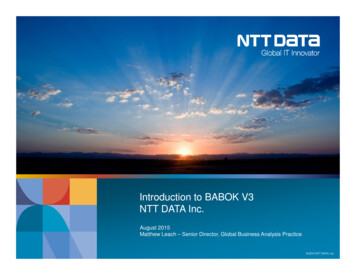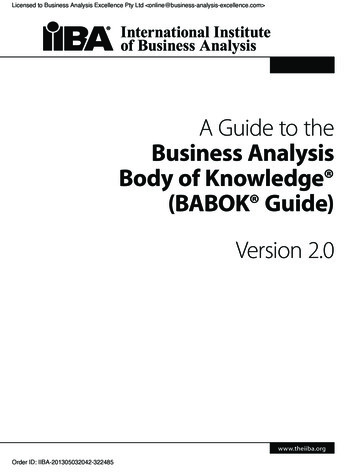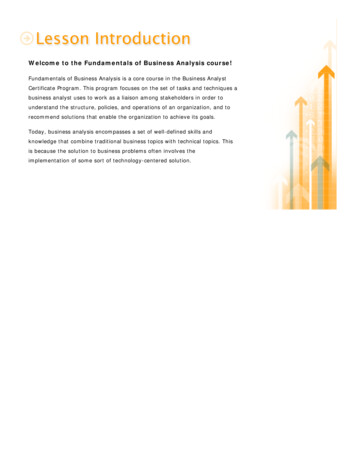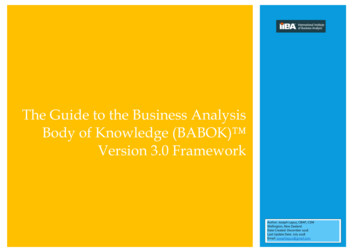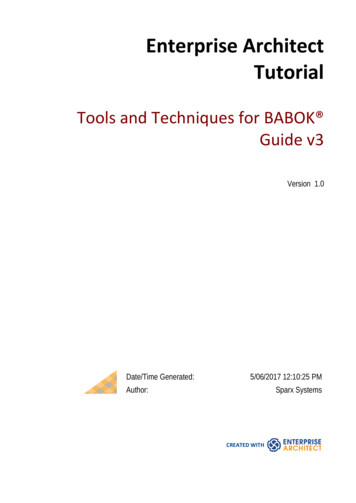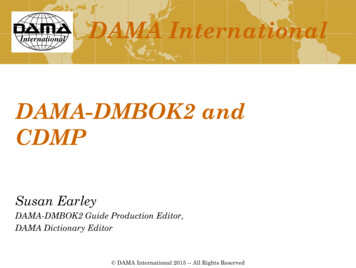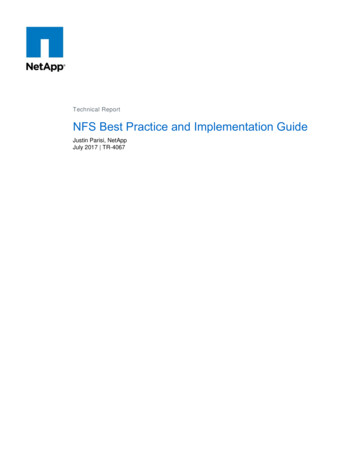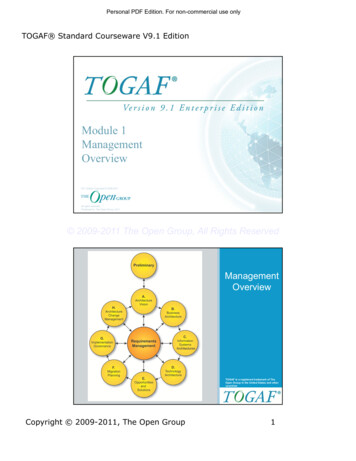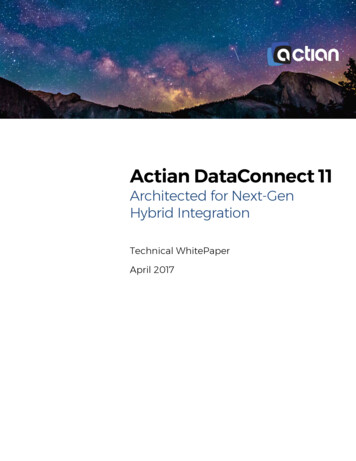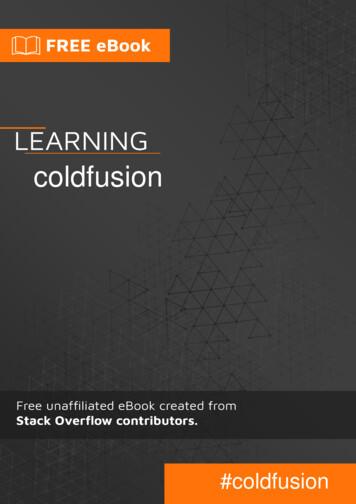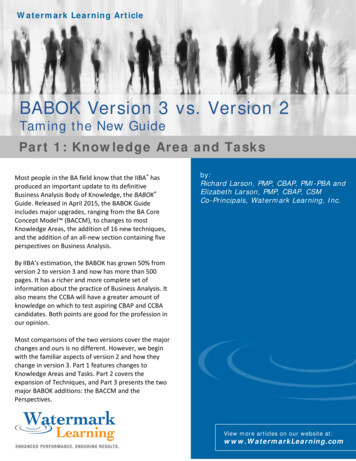
Transcription
Watermark Learning ArticleBABOK Version 3 vs. Version 2Taming the New GuidePart 1: Knowledge Area and TasksMost people in the BA field know that the IIBA hasproduced an important update to its definitiveBusiness Analysis Body of Knowledge, the BABOK Guide. Released in April 2015, the BABOK Guideincludes major upgrades, ranging from the BA CoreConcept Model (BACCM), to changes to mostKnowledge Areas, the addition of 16 new techniques,and the addition of an all-new section containing fiveperspectives on Business Analysis.by:Richard Larson, PMP, CBAP, PMI-PBA andElizabeth Larson, PMP, CBAP, CSMCo-Principals, Watermark Learning, Inc.By IIBA’s estimation, the BABOK has grown 50% fromversion 2 to version 3 and now has more than 500pages. It has a richer and more complete set ofinformation about the practice of Business Analysis. Italso means the CCBA will have a greater amount ofknowledge on which to test aspiring CBAP and CCBAcandidates. Both points are good for the profession inour opinion.Most comparisons of the two versions cover the majorchanges and ours is no different. However, we beginwith the familiar aspects of version 2 and how theychange in version 3. Part 1 features changes toKnowledge Areas and Tasks. Part 2 covers theexpansion of Techniques, and Part 3 presents the twomajor BABOK additions: the BACCM and thePerspectives.View more articles on our website at:1www.WatermarkLearning.com
BABOK Version 3 vs. Version 2 (cont.)BABOK Version 3 Knowledge Areas and TasksWe are starting the BABOK differences with the Knowledge Areas (KAs) and tasks instead of the Core ConceptModel for two main reasons. First, most people are familiar with the KAs and their tasks, so it makes the jump tov3 a little less of a leap. Second, the BACCM surrounds the KAs and for each KA the BABOK Guide version 3 showshow the BACCM applies to it. Our view is that v3 is not as big a change as one might think when doing a KA to KAcomparison.Below is a table we compiled to show the differences in tasks. After finishing a draft we then consulted with theBABOK Guide’s table of differences and the result is shown in Table 1.Some tasks have not changed much or at all, such as “Plan Business Analysis Approach” or “Verify Requirements. “The task names of some 10-11 tasks have remained the same, which means roughly 21 tasks have been changed,added or deleted. There are now only 30 tasks compared with 32 in v2.BABOK Guide Version 2 Knowledge Area and Task Names2.0 BA Planning and Monitoring – v2.0 tasks2.1 Plan Business Analysis Approach (content for prioritizationand change management moved to Plan BA Governance)2.3 Plan Business Analysis Activities2.2 Conduct Stakeholder Analysis2.4 Plan Business Analysis Communication2.5 Plan Requirements Management Process(see note for Plan BA Approach)New Task:2.6 Manage Business Analysis Performance3.0 Elicitation – v2.0 tasks3.1 Prepare for Elicitation3.2 Conduct Elicitation Activity3.3 Document Elicitation Results4.4 Prepare Requirements Package3.5 Communicate Requirements(Note: ours is more complete than the BABOK comparison)3.4 Confirm Elicitation ResultsNew Task:4.0 Requirements Management and Communication –v2.0 tasks4.1 Manage Solution Scope and Requirements4.2 Manage Requirements Traceability4.3 Maintain Requirements for Re-Use6.1 Prioritize Requirements (from Requirements Analysis)4.4 Prepare Requirements Package4.5 Communicate Requirements (both become part of“Communicate BA Information” in Elicitation and Collaboration)BABOK Guide Version 3 Knowledge Area and Task Names(additions/changes in v3)3.0 BA Planning and Monitoring – v3.0 tasks3.1 Plan Business Analysis Approach3.3 Plan Business Analysis Governance3.2 Plan Stakeholder Engagement3.4 Plan Business Analysis Information Management3.4 Plan Business Analysis Information Management3.5 Identify Business Analysis Performance Improvements4.0 Elicitation and Collaboration – v3.0 tasks4.1 Prepare for Elicitation4.2 Conduct Elicitation4.4 Communicate Business Analysis Information4.3 Confirm Elicitation Results4.5 Manage Stakeholder Collaboration5.0 Requirements Life Cycle Management –v.3.0 tasks5.1 Trace Requirements (Especially relationships)5.5 Approve Requirements (Conflict and Issue Management;Approval was formerly an element)5.1 Trace Requirements (“Configuration Management System”becomes “Traceability Repository”)5.4 Assess Requirements Changes(Impact Analysis moved here)5.2 Maintain Requirements5.3 Prioritize Requirements (Moved from Requirements Analysisin v2)4.4 Communicate Business Analysis Information Watermark Learning, Inc. All rights reserved worldwide. Unmodified copies allowed.
BABOK Version 3 vs. Version 2 (cont.)5.0 Enterprise Analysis – v2.0 tasksNew Task:5.1 Define Business Need5.2 Assess Capability Gaps5.3 Determine Solution Approach5.4 Define Solution Scope7.4 Define Transition Requirements6.4 Define Change Strategy6.3 Assess Risks (was an Element in v2 Business Case task)7.6 Analyze Potential Value and Recommend Solution(Business Case is also now a General Technique)7.0 Requirements Analysis and Design Definition –v3.0 tasks5.5 Define Business Case6.0 Requirements Analysis – v2.0 tasks6.1 Prioritize Requirements(Moved to Requirements Life Cycle Management)6.2 Organize Requirements6.3 Specify and Model Requirements5.3 Prioritize Requirements6.4 Define Assumptions and Constraints6.5 Verify Requirements6.6 Validate RequirementsNew Task:New Task:7.0 Solution Assessment & Validation - v2.0 tasks7.1 Assess Proposed Solution7.2 Allocate Requirements7.3 Assess Organizational Readiness7.4 Define Transition Requirements7.5 Validate Solution7.6 Evaluate Solution Performance5.5 Approve Requirements6.0 Strategy Analysis – v3.0 tasks6.1 Analyze Current State6.2 Define Future State6.1 Analyze Current State6.2 Define Future State6.4 Define Change Strategy6.2 Define Future State6.4 Define Change Strategy7.5 Define Design Options7.6 Analyze Potential Value and Recommend Solution(Note: ours is more complete than the BABOK comparison)New Task:New Task:New Task:7.4 Define Requirements Architecture7.1 Specify and Model Requirements6.2 Define Future State7.6 Analyze Potential Value and Recommend Solution7.2 Verify Requirements7.3 Validate Requirements7.5 Define Design Options (pulls together v2 Determine SolutionApproach, Assess Proposed Solution, and Allocate Requirements)7.6 Analyze Potential Value and Recommend Solution(pulls together v2 Define Business Case and Assess ProposedSolution)8.0 Solution Evaluation – v3.0 tasks7.5 Define Design Options7.6 Analyze Potential Value and Recommend Solution7.5 Define Design Options6.4 Define Change Strategy6.4 Define Change Strategy(Also see Requirements Classification Schema)8.3 Assess Solution Limitations8.5 Recommend Actions to Increase Solution Value8.1 Measure Solution Performance8.2 Analyze Performance Measures8.4 Assess Enterprise LimitationsTable 1: BABOK v2 vs. v3 KA and Task Differences (table modified from BABOK Guide version 3) Watermark Learning, Inc. All rights reserved worldwide. Unmodified copies allowed.
BABOK Version 3 vs. Version 2 (cont.)BABOK Version 3 Knowledge Areas andTasks Summary The changes to BABOK Knowledge Areas and theirassociated tasks on the surface may seem to besignificant. Only one KA name (BA Planning andMonitoring) survives intact from v2 to v3. Only ninetask names are the same or roughly the same. Thisarticle does not cover details like inputs and outputs,and many of those names have changed from onerelease to the next.Upon closer examination, though, the changes areactually not so dramatic. We can summarize a fewobservations. Even though most KA and task names havechanged, in many cases they are merelyrefinements rather than significant changes. Forexample:o The Elicitation KA in v2 is now Elicitationand Collaboration. Most tasks in that KA arethe same with the addition of the “ManageStakeholder Collaboration” task.o The v2 “Conduct Stakeholder Analysis” taskin Planning and Monitoring has beenchanged in v3 to “Plan StakeholderEngagement”The Requirements Management andCommunication KA and Requirements Life CycleManagement (RLCM) are essentially similar. Animportant addition is that prioritize Requirementsis placed in RLCM.Enterprise Analysis has become Strategy Analysis,essentially broadening its scope. It now includesdevising change strategies, transitions, andorganization readiness. Requirements Analysis is similar in v2 and v3,despite the addition of the concept of “Design.”.An important distinction has been made by IIBAbetween requirements and design, which boilsdown to the distinction between business needsand solutions to those needs.o Requirements – the usable representationof a need (see our forthcoming article onthe BA Core Concept Mode).o Designs – usable representation of aSolution. A new task “Define DesignOptions” has been added to focus on theBA work in designing solutions. Anothernew task “Analyze Potential Value andRecommend Solution” actually pullstogether facets of two tasks from v2.Solution Assessment and Validation has beenrenamed as Solution Evaluation. There are threenew tasks as the table shows. They were added toclarify the work of evaluating solution performanceover its lifetime including organizationalconstraints.Out of the 32 tasks in v2, only eight have beenadded, a 25% change. That means 10 have beenremoved since there are now 30 tasks in all.In short, BABOK version 3 is better organized than itspredecessor, and with refined KA and task namescontains a structure that better reflects the practice ofbusiness analysis.In the next part of this article, we explore changes toBA techniques in BABOK version 3. Watermark Learning, Inc. All rights reserved worldwide. Unmodified copies allowed.
BABOK Version 3 vs. Version 2 (cont.)Part 2: TechniquesIn Part 1 we started our comparison of BABOK version 3 and its predecessor, version 2. We outlined theKnowledge Area and Tasks that are changing with the new release and showed where the major changes areoccurring. Our view is there were substantive, but not necessarily shocking changes in the versions pertaining tothe KAs and Tasks. Now we turn our attention to the updates of the General Techniques in the latest BABOKversion.BABOK Version 3 TechniquesGeneral BABOK techniques are another major area of change in BABOK v3, which we cover second for similarreasons as we did for the KAs. Namely, the amount of familiarity people have for the v2 techniques will help makeunderstanding the changes in v3 a bit easier.Version 2 of the BABOK included 34 general techniques and 15 task-specific techniques. Version 3 has added 16additional general techniques, a whopping 47% increase. We could debate whether such an increase was needed,but one thing is certain: there are several new techniques to master if you plan to pass the CBAP or CCBA exam.And, for those using the BABOK as a general reference, Business Analysis has more techniques than ever that areregarded as generally accepted in the industry.See Table 2 below for a summary of both the stability and changes to general techniquesfrom BABOK version 2 to 3.Technique10.1 Acceptance and Evaluation CriteriaSameRenameNewX10.2 Backlog ManagementX10.3 Balanced ScoreboardX10.4 Benchmarking and Market Analysis10.5 BrainstormingXAdded “Market Analysis”X10.6 Business Capability AnalysisX10.7 Business CasesX10.8 Business Model CanvasX10.9 Business Rules AnalysisX10.11 Concept ModelingX10.12 Data Dictionary10.14 Data MiningWas a task in v2X10.10 Collaborative Games10.13 Data Flow DiagramsNotesXDropped “Glossary”XXMost applicable to BI Perspective10.15 Data Modeling Watermark Learning, Inc. All rights reserved worldwide. Unmodified copies allowed.
BABOK Version 3 vs. Version 2 (cont.)Technique10.16 Decision AnalysisSameRenameNewNotesX10.17 Decision Modelling10.18 Document AnalysisX10.19 EstimationX10.20 Financial Analysis10.21 Focus GroupsX10.22 Functional DecompositionX10.23 Glossary10.24 Interface AnalysisX10.25 InterviewsX10.26 Item TrackingXIncludes Decision Tables and Decision Trees,both part of “Decision Analysis” in v2XMoved from Enterprise Analysis in v2XSplit off from v2 Data Dictionary & GlossaryIn v2 were part of “Problem Tracking” and anElement in “Manage Solution Scope &Requirements”X10.27 Lessons LearnedX10.28 Metrics and Key Performance Indicators (KPIs)XDropped “Process” from title10.29 Mind MappingX10.30 Non-Functional Requirements AnalysisX10.31 ObservationX10.32 Organizational ModellingX10.33 PrioritizationXPreviously were techniques in “PrioritizeRequirements” in v210.34 Process AnalysisXIncludes SIPOC and Value Stream Mapping,arguably part of process modeling10.35 Process ModellingX10.36 PrototypingX10.37 ReviewsXFormerly “Structured Walkthrough” in v210.38 Risk Analysis and ManagementXFormerly “Risk Analysis” in v210.39 Roles and Permissions Matrix10.40 Root Cause AnalysisX10.41 Scope ModellingX10.42 Sequence DiagramsX10.43 Stakeholder List, Map, or Personas10.44 State Modelling10.45 Survey or QuestionnaireXXPreviously techniques in “ConductStakeholder Analysis” in v2XPreviously techniques in “ConductStakeholder Analysis” in v2Called “State Diagrams” in v2X Watermark Learning, Inc. All rights reserved worldwide. Unmodified copies allowed.
BABOK Version 3 vs. Version 2 (cont.)TechniqueSame10.46 SWOT AnalysisX10.47 Use Cases and ScenariosX10.48 User StoriesX10.49 Vendor AssessmentX10.50 WorkshopsRenameNewNotesXTable 2: BABOK v2 vs. v3 General Technique DifferencesBABOK Version 3 Technique SummaryAs you can see in the table above, all 34 general techniques from BABOK version 2 remained intact or wererenamed. Again, we could argue the wisdom of keeping all the techniques or the appropriateness of adding some ofthe narrower techniques. Like any Body of Knowledge, there will be tasks and techniques in BABOK Guide v3 thatwill never apply to a particular person’s job or career situation. The challenge becomes that of a) mastering thecontent enough to pass the CBAP or CCBA exam and/or b) deciding whether to use the particular techniques on thejob.Of the 16 “new” techniques, half of them are not actually new. Some have been moved out of task-specifictechniques, such as Business Cases. Some are divisions of other techniques such as Process Analysis, whichhas many similarities to Process Modeling.Table 3 below is our list of the truly new techniques added to BABOK version 3.New Technique10.2 BacklogManagement10.3 BalancedScorecard10.6 BusinessCapability Analysis10.8 Business ModelCanvas10.10 CollaborativeGames10.11 ConceptModelling10.14 Data Mining10.29 Mind MappingBABOK DescriptionUsed to record, track, and prioritize remaining work items.Relates ToUsed to manage performance in any business model, organizational structure, orbusiness process.Provides a framework for scoping and planning by generating a shared understandingof outcomes, identifying alignment with strategy, and providing a scope andprioritization filter.Describes how an enterprise creates, delivers, and captures value for and from itscustomers.Encourage participants in an elicitation activity to collaborate in building a jointunderstanding of a problem or a solution.Organize the business vocabulary needed to consistently and thoroughlycommunicate the knowledge of a domain.Used to improve decision making by finding useful patterns and insights from data.Used to articulate and capture thoughts, ideas, and information.BPM Perspective andProcess AnalysisAgile PerspectiveBPM Perspective andProcess AnalysisBPM Perspective andStrategyFacilitation andWorkshopsGlossaryBI PerspectiveConduct ElicitationTable 3: Truly New Techniques in BABOK Version 3In the next part of this article, we examine the two major additions to BABOK version 3: the BA Core Concept Modeland Business Analysis Perspectives. Watermark Learning, Inc. All rights reserved worldwide. Unmodified copies allowed.
BABOK Version 3 vs. Version 2 (cont.)Part 3: BA Core Concept Model and PerspectivesIn our continuing series on BABOK version 3 vs.version 2, we conclude with the two major additionsmade by IIBA: the BA Core Concept Model (BACCM)and an all-new section containing five perspectives onBusiness Analysis. This article provides a summary ofthe new BACCM, a practical definition of the six coreconcepts, and an example of each. This article alsodescribes the new Perspectives and provides examplesof the common elements in all the Perspectives.framework for all business analysis work, and can beapplied across industries, methodologies, projects, andorganizational cultures. It shows the interrelationshipsamong six core concepts: Needs, Solutions, Changes,Stakeholders, Value, and Contexts. There is no order tothese six concepts that can be read in a variety ofdifferent patterns. Let’s look at each of these sixconcepts and then some of the ways each relates tothe others.BA Core Concept ModelTM (BACCM)Needs refer to business problems that require solvingor opportunities that can be seized. Needs are satisfiedby Solutions.Solutions are the products and services that provideways to take advantage of opportunities and solvebusiness problems. Solutions are developed throughChanges consisting of one or several projects,programs, or initiatives. Examples include installationof commercial software and changes to the currentprocesses, development of a new medical device,creation of a marketing campaign, or implementationof new regulations.Changes are the steps involved in transforming Needsinto Solutions. Note that the word “Change” is used inthe BABOK Guide in lieu of the terms “Project” and“Program.”Stakeholders are individuals or groups that haveNeeds, an interest in the Solution, and/or are affectedby the Changes.Figure 1 above, published by IIBA in the BABOK Guideversion 3.0, shows the BACCM.One of the key changes in the BABOK Guide version3.0 is the introduction of the Business Analysis CoreConcept Model (BACCM). This model defines theValue. Solutions need to provide Value to theorganizations and Stakeholders. If Solutions do notprovide Value, they have not met the Need. Businessanalysis is really all about delivering Value to theorganization.Contexts are all those things that affect and arerelevant to the Changes. This is the environment in Watermark Learning, Inc. All rights reserved worldwide. Unmodified copies allowed.
BABOK Version 3 vs. Version 2 (cont.)which the Solution will be developed and includes suchthings as organizational culture, as well as the cultureof the various countries that might be involved,languages, organizational process assets andenvironmental factors, constraints like weather,seasons, or other things happening at an organizationor within a division or department.Let’s look at an example of these interrelationships.Need. A sponsor is concerned about losing marketshare to a competitor. One of the problems thatcontributes to this loss is the limited informationprovided by the set of Order reports she currentlyreceives. Her Need, then, is the limited Orderinformation inhibiting her ability to make good buyingdecisions.Solution. After some analysis and a business case, thebusiness analyst has recommended commercialbusiness analytics software as a Solution. This is acomplex Solution that will involve multiple projectsaddressing such things as processes, software, andnew technology to name a few.Changes. The Changes to the organization will besignificant. The analysis of the current state anddefinition of the future state done during StrategyAnalysis will need to be refined and expanded. Someof the Changes include designing new processes,purchasing new software, modifying data structures inexisting interfacing applications, capturing new data,building technical ways to transition to the newsoftware, and more.Stakeholders. Stakeholders including buyers,merchandisers, advertising staff, distribution centers,retail store personnel, customer service specialists,several vendors, and many areas in IT will be affectedglobally.Value. This Solution will provide Value to the sponsor,many Stakeholders, and the organization. The businesscase included a cost/benefit analysis which showedthat although the costs were high, the organizationwould start seeing a benefit within a year. Severalsolution performance measures were identified duringSolution Evaluation to help measure the realized value.Contexts. Since this is a complex project with globallydistributed Stakeholders, there are many Contexts thatneed to be considered. Each country’s laws andregulations, the various national cultures, as well asthe different departmental cultures will affect thedevelopment of the Solution. For example andspeaking generally, the distribution staff tends to becasual, the buyers more goal-driven and direct, andthe advertisers more expressive. In addition, one ofthe facilities is in central Europe, which has recentlyexperienced massive flooding. Finally, monsoonseason is approaching India, where some of thetechnical and support staff are located.Understandably not all Solutions and Changes are ascomplex as this one. This example was meant toprovide an understanding of each of these six coreconcepts and how they fit together.PerspectivesThe BABOK Guide Perspectives are focused areas thatneed to be addressed depending on the nature of theproject. Each Perspective provides how businessanalysis work is completed and its uniquecharacteristics on projects with these Perspectives: AgileBusiness IntelligenceInformation TechnologyBusiness ArchitectureBusiness Process Management (BPM)Some projects will have multiple perspectives. Abusiness analytics application, for example, might haveelements from all five perspectives. Watermark Learning, Inc. All rights reserved worldwide. Unmodified copies allowed.
BABOK Version 3 vs. Version 2 (cont.)Each perspective is organized into five sections: Change scope (think project scope) includes suchthings as which areas of the organization areimpacted and will be affected by the approachtaken. For example, the Agile perspective alludesto a constantly changing scope. The BPMperspective contains four typical lifecycle stagesand several methods to outline the scope.Business analysis scope includes the scope of thebusiness analysis work, including which artifacts orwork products will be produced and whichstakeholders will be involved in the change. Forexample, the Agile perspective notes that theamount of rigor applied to documentation, abusiness analysis work product, is dependent onthe nature of the project.Methodologies, approaches, and techniques. EachPerspectives might have some specificmethodologies or approaches that are unique tothat Perspective. Scrum, for example, is an AgileMethodology. Information Technology has its owndevelopment life cycles. As an example of atechnique, Prioritization is listed as a generaltechnique, but in the Agile perspective MoSCoWprioritization is listed as an Agile-specific type ofprioritization. Underlying competencies include those that aremost relevant to each perspective. They do nothave to be unique and might be relevant to otherPerspectives as well. For example, theCommunications and Collaboration technique islisted as an underlying competency in the Agileperspective. Collaboration Games is listed as ageneral technique. Communications Skills is listedas a general underlying competency.Impact on Knowledge Areas shows a mapping ofspecific activities relevant to the Perspective to theBABOK Guide tasks. For example, the AgilePerspective discusses the relationship to theRequirements Life Cycle Knowledge Area, statingthat requirements are defined with increasingdetail and that validation of requirements is doneat the end of each iteration. The BI Perspectivementions overcoming barriers to utilizing newanalytic tools and techniques in SolutionEvaluation.This article has provided a summary of the newBACCM and Perspectives with some examples to helpdecipher these new concepts. The overall series ofarticles gives an in-depth look at the new BABOKversion 3. The new Guide represents a major increasein content and improvement over version 2. Our goalwas to explain the major changes and additions, and tostructure and simplify it.Contact us at info@WatermarkLearning.com if youwould like information on our services to help yourorganization apply BABOK 3 or to prepare for theexams based in it.About Watermark LearningSince 1992 Watermark Learning has provided training that turns the complexity of industrystandards into practical application. Our courses are laser-focused to enhance performance forbusiness analysts, project managers, and process analysts and lead to enduring results inorganizations. Our interactive classes engage students to learn and motivate them to perform. Watermark Learning, Inc. All rights reserved worldwide. Unmodified copies allowed.7301 Ohms Lane, Suite 360Minneapolis, MN 55439( 1) 952-921-0900800-646-9362 (USA only)www.WatermarkLearning.com
Business Analysis Body of Knowledge, the . BABOK Guide. Released in April 2015, the BABOK Guide includes major upgrades, ranging from the BA Core Concept Model (BACCM), to changes to most Knowledge Areas, the addition of 16 new techniques, and the addition of an all-new section containing
